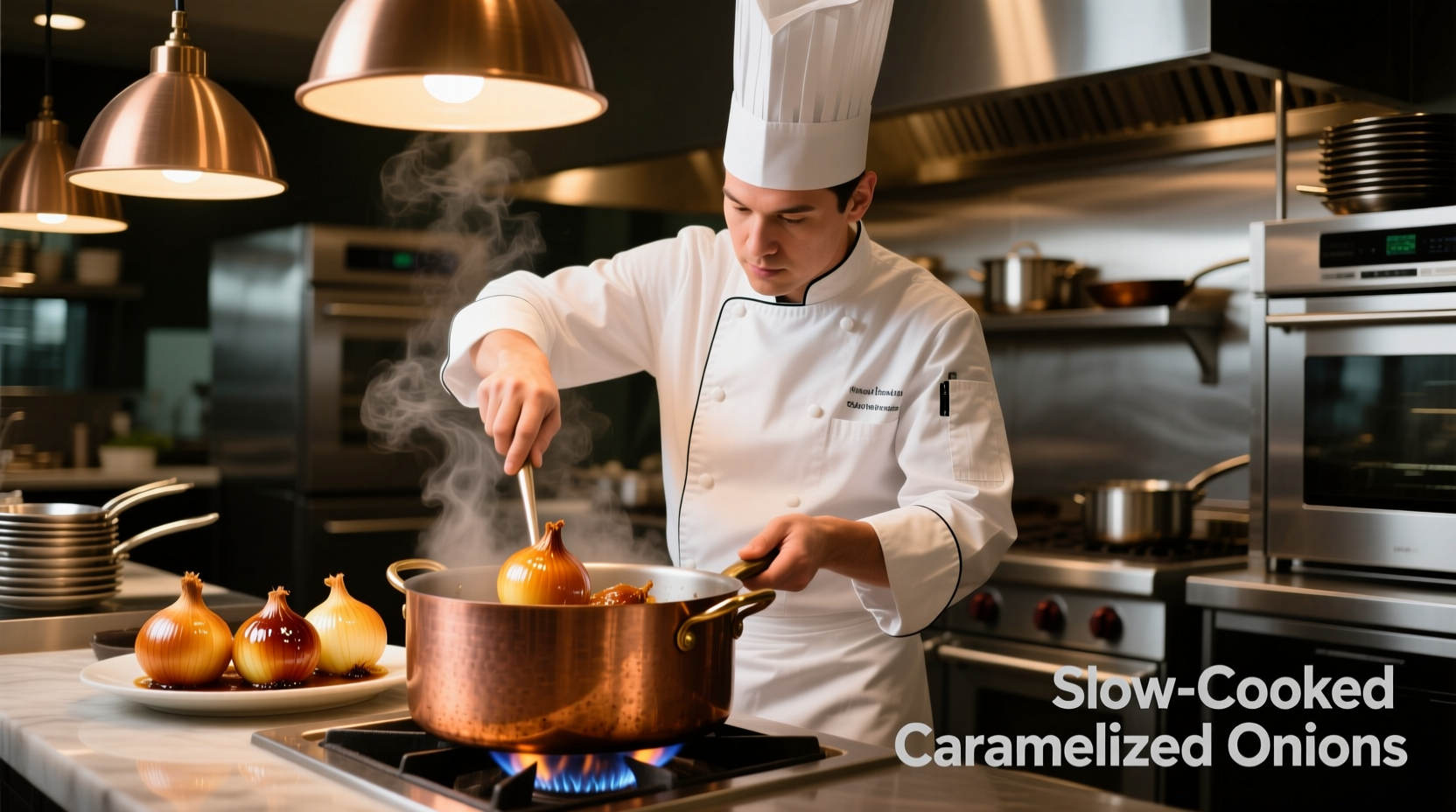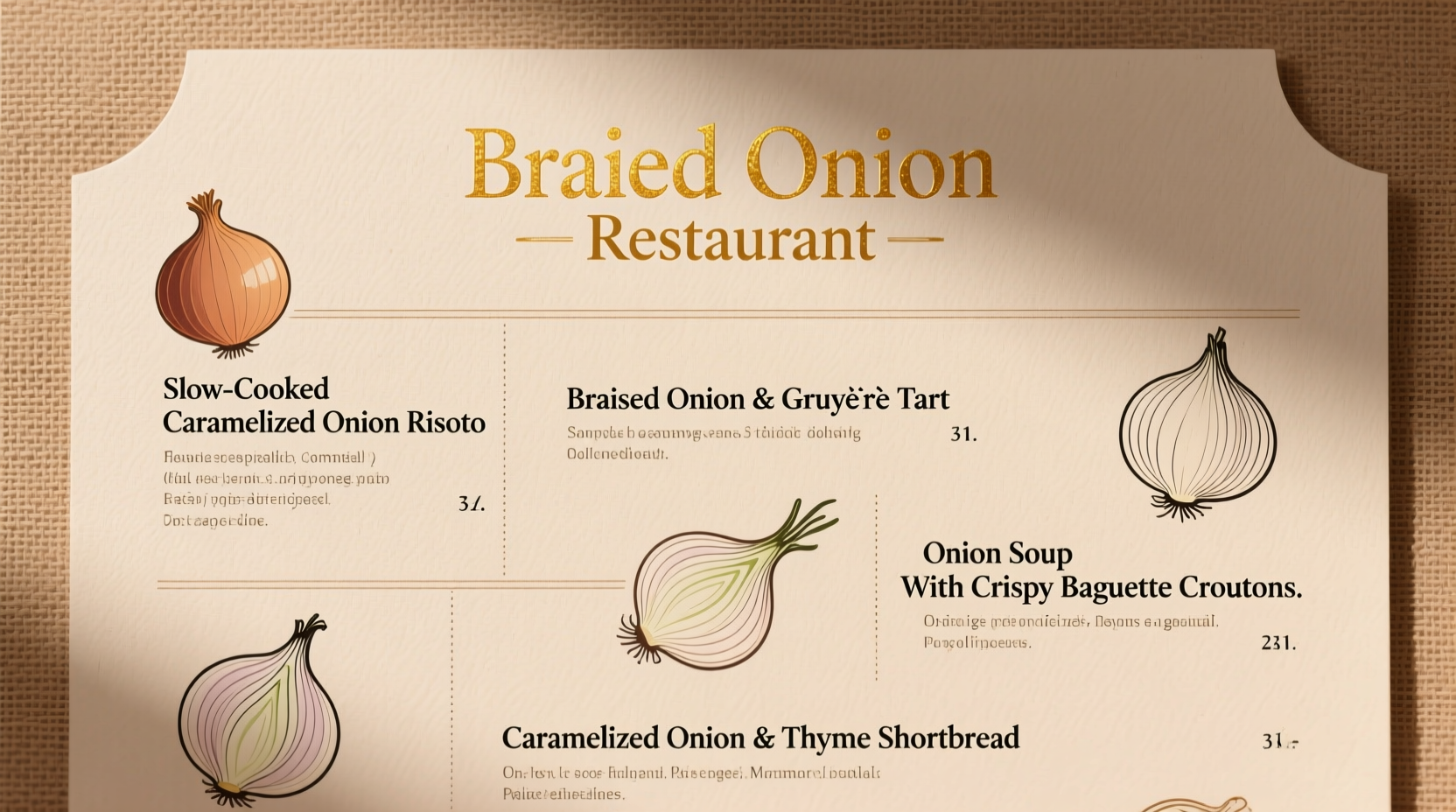Restaurants feature braised onions as a versatile, flavor-enhancing component that transforms simple dishes through slow-cooked sweetness and depth. You'll commonly find them paired with proteins like steak or chicken, incorporated into French onion soup, or served as standalone vegetarian sides across American, French, and Asian cuisines.
Discover exactly how braised onions elevate restaurant menus and what makes them worth ordering. This comprehensive guide reveals why professional kitchens rely on this humble preparation technique, which menu items deliver the most authentic experience, and how to identify quality braised onion dishes regardless of cuisine type. You'll gain practical knowledge to make informed choices whether dining at a casual bistro or fine dining establishment.
The Culinary Evolution of Braised Onions
Braised onions have evolved from peasant food to gourmet staple through centuries of culinary refinement. This slow-cooking technique transforms sharp alliums into sweet, tender morsels that enhance countless dishes across global cuisines. Understanding this evolution helps you appreciate why restaurants continue featuring them prominently on menus today.
| Era | Culinary Development | Menu Significance |
|---|---|---|
| 16th Century | French & Dutch home cooks developed slow-cooking techniques using available fats | Peasant food using affordable ingredients |
| 18th Century | Appeared in professional kitchens as "confit d'oignons" | Accompaniment to roasted meats in taverns |
| Early 1900s | Standardized in Escoffier's Le Guide Culinaire | Essential component of French cuisine worldwide |
| Modern Era | Chefs experiment with global flavor variations | Featured in fusion dishes across diverse restaurant menus |
This historical progression demonstrates why braised onions remain a kitchen workhorse. According to the Culinary Institute of America's research on fundamental cooking techniques, the Maillard reaction during braising creates over 600 distinct flavor compounds that enhance dish complexity (CIA, 2023). Modern restaurants leverage this science to create memorable dining experiences that keep customers returning.
What Exactly Makes Restaurant Braised Onions Special
Unlike home preparations, professional kitchens achieve consistent quality through precise temperature control and ingredient selection. Restaurants typically use specific onion varieties based on the desired flavor profile:
- Yellow onions - Most common choice providing balanced sweetness and depth
- Red onions - Used when visual contrast matters, like in gourmet burgers
- Shallots - Preferred for delicate sauces requiring subtle onion flavor
- Pearl onions - Featured in upscale preparations for visual appeal
The braising process itself follows strict protocols. Chefs begin by caramelizing onions slowly over low heat, then add liquid (usually broth or wine) before covering and cooking until tender. This two-stage method creates complex flavors impossible through simple sautéing. According to USDA food science research, the extended cooking time breaks down sulfur compounds responsible for raw onion's sharpness while developing natural sugars (USDA Food Science, 2024).

Where to Find Braised Onions on Restaurant Menus
Braised onions appear across menu sections depending on the restaurant's culinary focus. Recognizing these patterns helps you identify quality preparations:
Appetizers & Small Plates
Many establishments feature braised onions as standalone starters or components:
- French onion soup (classic preparation with Gruyère topping)
- Onion tartlets with goat cheese and herbs
- Caramelized onion dip served with artisanal bread
Main Courses
This is where braised onions truly shine as supporting elements:
- Steak houses - Almost always paired with premium cuts like filet mignon
- Italian restaurants - Incorporated into braised short rib preparations
- Asian fusion - Used in Korean bulgogi or Japanese nikujaga
- Diner classics - Topping for meatloaf or Salisbury steak
Vegetarian & Vegan Options
Forward-thinking restaurants increasingly feature braised onions as centerpieces:
- Portobello mushrooms stuffed with braised onions and grains
- Vegetable Wellington with layered braised onions
- Plant-based "steak" alternatives featuring onion-based sauces
How to Identify Quality Braised Onion Dishes
Not all menu items featuring braised onions deliver equal quality. Use these professional chef indicators to make informed choices:
| Quality Indicator | What to Look For | Red Flags |
|---|---|---|
| Preparation Method | "Slow-braised" or "house-made" description | Vague terms like "onion topping" without preparation details |
| Onion Variety | Specific mention of onion type (shallots, Vidalia, etc.) | Generic "onions" without specification |
| Flavor Enhancers | References to wine, herbs, or specialty broths | No mention of additional flavor components |
| Menu Placement | Featured as integral component rather than afterthought | Appears only in "add-ons" section for extra charge |
Professional chefs consider properly executed braised onions a benchmark of kitchen competence. When reviewing menus, prioritize establishments that treat this preparation with respect rather than as an afterthought. Restaurants serious about culinary quality will often highlight their braising technique in menu descriptions.
Nutritional Considerations for Health-Conscious Diners
Braised onions offer surprising nutritional benefits that many diners overlook. While cooking does reduce some vitamin content, the process actually increases certain beneficial compounds:
- Quercetin levels increase during slow cooking, providing antioxidant benefits
- Digestibility improves significantly compared to raw onions
- Natural sweetness reduces need for added sugars in dishes
- Lower glycemic impact than many other cooked vegetables
The American Heart Association notes that properly prepared allium vegetables like braised onions contribute to heart-healthy diets when prepared with minimal added fats (AHA, 2024). When ordering, ask about preparation methods to ensure they align with your dietary needs.
Maximizing Your Braised Onion Dining Experience
Understanding how to approach menu selections featuring braised onions enhances your dining experience. Consider these practical tips when reviewing restaurant offerings:
- Ask about preparation time - Quality braised onions require minimum 45-60 minutes of cooking
- Check for complementary pairings - Look for dishes where onions enhance rather than dominate
- Inquire about onion varieties - Different types create distinct flavor profiles
- Consider the sauce base - Wine-based braises offer different complexity than broth-based
When in doubt, don't hesitate to ask your server about the kitchen's approach to braised onions. Restaurants proud of their preparation will happily share details about their technique and ingredient selection. This simple inquiry often leads to special preparations or chef's recommendations you won't find on the printed menu.
Final Thoughts on Braised Onions in Restaurant Menus
Braised onions represent culinary alchemy at its finest - transforming a humble ingredient into something extraordinary through time and technique. As you explore restaurant menus, recognize these preparations as markers of kitchen skill and attention to detail. Whether featured prominently or used as supporting elements, properly executed braised onions elevate dishes across virtually all culinary traditions. Armed with this knowledge, you can make informed choices that lead to more satisfying dining experiences regardless of cuisine type or price point.











 浙公网安备
33010002000092号
浙公网安备
33010002000092号 浙B2-20120091-4
浙B2-20120091-4